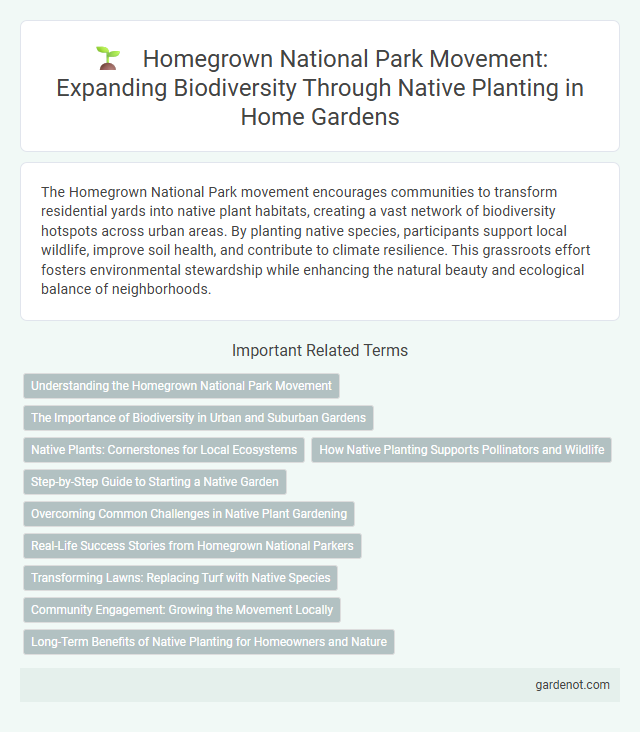The Homegrown National Park movement encourages communities to transform residential yards into native plant habitats, creating a vast network of biodiversity hotspots across urban areas. By planting native species, participants support local wildlife, improve soil health, and contribute to climate resilience. This grassroots effort fosters environmental stewardship while enhancing the natural beauty and ecological balance of neighborhoods.
Understanding the Homegrown National Park Movement
The Homegrown National Park movement advocates transforming private yards into vibrant native plant habitats to support biodiversity and combat habitat loss across North America. This grassroots effort emphasizes planting native species to create resilient ecosystems that benefit pollinators, birds, and soil health, fostering urban and suburban wildlife corridors. By engaging individuals in conservation through native gardening, the movement aims to restore ecological balance at a large scale, reinforcing the importance of local flora in sustaining environmental resilience.
The Importance of Biodiversity in Urban and Suburban Gardens
The Homegrown National Park movement emphasizes the critical role of biodiversity in urban and suburban gardens by encouraging homeowners to plant native species that support local ecosystems. Native plants provide essential habitat and food sources for pollinators, birds, and other wildlife, enhancing ecological resilience and promoting a balanced environment. Increasing native vegetation in residential areas strengthens biodiversity, mitigates climate impacts, and fosters healthier, more sustainable urban landscapes.
Native Plants: Cornerstones for Local Ecosystems
The Homegrown National Park movement advocates for planting native plants as essential cornerstones for local ecosystems, promoting biodiversity and resilience. Native plants support pollinators, improve soil health, and enhance habitat stability for wildlife. By integrating indigenous flora into residential landscapes, communities contribute significantly to restoring ecological balance and combating environmental degradation.
How Native Planting Supports Pollinators and Wildlife
Native planting enhances biodiversity by providing essential habitat and food sources for pollinators like bees, butterflies, and birds, which rely on indigenous flora for nectar and shelter. The Homegrown National Park movement advocates transforming residential yards into native plant sanctuaries, increasing urban wildlife corridors and supporting ecosystems. Improved native plant coverage also fosters natural pest control and soil health, promoting resilient local environments vital for sustaining pollinator populations.
Step-by-Step Guide to Starting a Native Garden
Starting a native garden begins with selecting local plant species adapted to your region's climate and soil conditions, ensuring sustainability and supporting local ecosystems. Prepare your soil by removing invasive plants and enriching it with organic matter to create an ideal environment for native roots to establish. Planting in phases, beginning with hardy perennials and progressively adding shrubs and trees, promotes biodiversity and enhances habitat connectivity as advocated by the Homegrown National Park movement.
Overcoming Common Challenges in Native Plant Gardening
Native plant gardening faces challenges such as limited availability of local provenance seeds, soil degradation, and invasive species competition. The Homegrown National Park movement promotes sourcing region-specific native seeds and amends soil through organic matter to improve plant health. Community-led restoration efforts and educational resources help gardeners manage invasive species and foster resilient native ecosystems.
Real-Life Success Stories from Homegrown National Parkers
Homegrown National Parkers have transformed urban spaces by planting native species, creating vibrant ecosystems that support local wildlife and improve biodiversity. Real-life success stories highlight neighborhoods where native gardens have increased pollinator populations and strengthened community connections through shared ecological stewardship. These efforts demonstrate the tangible benefits of restoring indigenous plants, showcasing measurable improvements in air quality, soil health, and habitat restoration.
Transforming Lawns: Replacing Turf with Native Species
The Homegrown National Park movement advocates transforming traditional lawns by replacing non-native turf grass with diverse native plant species to support local ecosystems. Native plants improve soil health, increase biodiversity, and provide critical habitat for pollinators like bees and butterflies. This approach reduces water usage and chemical inputs, promoting sustainable, eco-friendly gardens that contribute to regional conservation efforts.
Community Engagement: Growing the Movement Locally
The Homegrown National Park movement empowers communities to restore native habitats by planting indigenous species in local yards and public spaces, enhancing biodiversity and ecosystem health. Active community engagement includes organizing workshops, seed exchanges, and neighborhood planting events to foster collective environmental stewardship. This localized participation accelerates the expansion of native plant networks, creating resilient urban ecosystems that support native wildlife and mitigate climate impacts.
Long-Term Benefits of Native Planting for Homeowners and Nature
Native planting supports biodiversity, improves soil health, and enhances water retention, creating resilient landscapes that benefit both homeowners and ecosystems. The Homegrown National Park movement emphasizes long-term environmental gains by encouraging the restoration of native habitats, reducing the need for chemical inputs and costly maintenance. These native plants provide essential food and shelter for pollinators and wildlife, fostering ecological balance and promoting sustainable gardening practices for future generations.
Homegrown National Park movement Infographic

 gardenot.com
gardenot.com